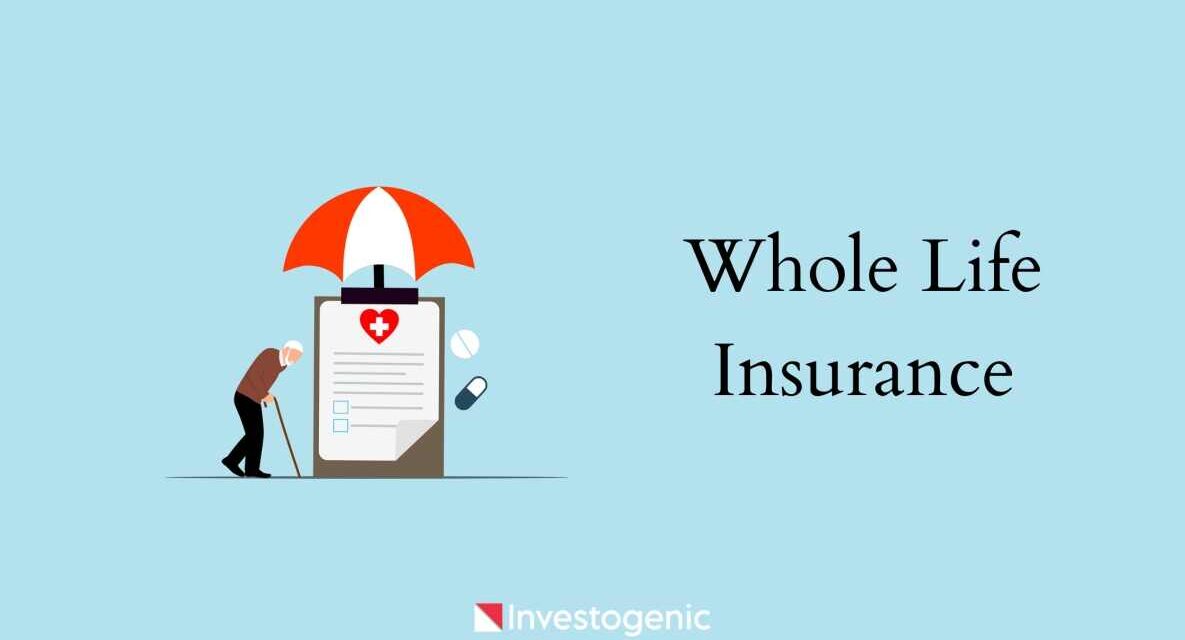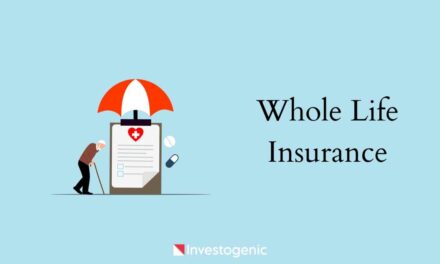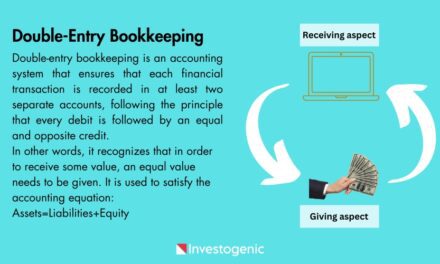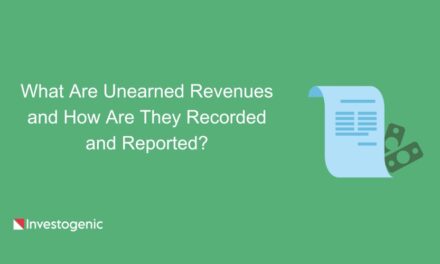
Whole Life Insurance: An Overview

What is whole life insurance?
Whole life insurance is a type of permanent life insurance that provides coverage for the insured’s entire lifetime, as long as the premiums are paid. Unlike term life insurance, which provides coverage for a specific period (10, 20, or 30 years), whole life insurance does not have an expiration date.
The Whole life insurance policy is permanent, and the death benefit is guaranteed. This policy lasts the rest of your life and can also build cash value over time as you pay the premiums.
Following are a few essential aspects of whole life insurance:
- Whole Life Coverage: As the name of the whole life insurance policy suggests, in this policy, as long as you continue to pay the premiums, the policy remains in force till the death of the insured, regardless of age, as it is designed to cover the entire lifetime of the insured.
- Fixed Premiums: The whole life insurance premiums are normally constant and steady during the course of the policy. This stability can make it simpler for policyholders to plan their long-term budget for insurance expenses.
- Guaranteed Death Benefit: Whole life insurance guarantees a death benefit to be paid to the beneficiaries when the insured passes away. The death benefit is generally tax-free and can provide financial protection to your loved ones after you’re gone.
- Cash Value Accumulation: The accumulation of cash value is one of the special characteristics of whole life insurance. A portion of the premium payments is used to create a cash value component, which develops gradually and is tax-deferred over time. Through policy loans or withdrawals, policyholders can gain access to this cash value, offering a potential source of funds for unanticipated or scheduled needs.
- Dividends (for Participating Policies): Some whole life insurance policies are “participating policies” issued by mutual insurance companies. These policies can be qualified to earn dividends, which are payments made to policyholders from the insurer’s profits. The option for policyholders to receive dividends in cash, cut premium payments, or reinvest them to raise the cash value and death benefit is available.
- Higher Premiums: Whole life insurance generally has higher premiums compared to term life insurance for the same death benefit amount. This is because part of the premium goes toward building cash value and covering the cost of insuring the individual for their entire life.
Types of Whole Life Insurance
Whole life insurance comes in a variety of forms, each of which is created to meet a certain set of requirements and preferences. The most typical kinds of whole life insurance are as follows:
- Traditional Whole Life Insurance: The most fundamental and typical type of whole life insurance is this one. It offers a death benefit that is guaranteed, levels premiums, and accrues cash value over time. A portion of the premium paid by the policyholder, which is fixed for the duration of the policy, is invested in the cash value component, which increases tax-deferred.
- Participating Whole Life Insurance: Mutual insurance companies provide participating whole life insurance, also referred to as “par” or “with-profits” policies. Depending on the company’s financial performance, these policies might provide dividends to policyholders. The dividends are available to policyholders in cash, as a reduction in premiums, or for reinvestment to raise the cash value and death benefit.
- Non-Participating Whole Life Insurance: Whole life insurance policies that do not participate in the profits of the insurer do not distribute dividends. The growth of the cash value and death benefit are often guaranteed and unaffected by changes in the business’s financial health.
- Limited Payment Whole Life Insurance: The policyholder pays premiums for this kind of coverage for a set amount of time, which may be a set number of years or up to a given age. The coverage remains in effect for the duration of the insured’s life after all premium payments have been made, and the cash value keeps increasing.
- Single Premium Whole Life Insurance: With this kind of coverage, the policyholder must pay the entire premium upfront in one lump sum. The coverage and cash value are then guaranteed for the duration of the insured person’s life and the policy is fully paid up.
- Adjustable Life Insurance: This kind of whole life insurance policy, also referred to as “flexible premium” or “flexible death benefit” whole life insurance, enables the policyholder to modify the death benefit and premium payments over time. It offers versatility in adjusting the coverage to evolving needs and situations.
- Survivorship Whole Life Insurance: Two people (often a husband and wife) are covered by a single Survivorship Whole Life Insurance policy, and the death benefit is paid following the passing of both insured parties. Due to its ability to reduce inheritance taxes and facilitate the transfer of funds to recipients, survivorship life insurance is frequently utilized for estate planning.
How Whole Life Insurance Works
Whole life insurance guarantees payment of a death benefit to beneficiaries in exchange for level, regularly due premium payments. This policy includes a savings account called the “cash value” with the death benefits. In the savings component, which means cash value, interest may accumulate on a tax-deferred basis. Growing cash value is an essential component of whole life insurance.
The Whole Life Insurance Cash Value
The accumulated savings or investment portion of a whole life insurance policy is referred to as the cash value. A portion of the premiums paid by policyholders goes toward supporting the death benefit, and a piece is deposited into a different account known as the cash value.
A whole life insurance policy’s cash value offers some flexibility and financial advantages. It can provide money for unanticipated expenses, educational costs, retirement additions, or other financial needs. However, using the cash value to make loans or withdrawals may have an effect on the policy’s death benefit and may have tax repercussions.
It’s important for policyholders to review the terms and conditions of their whole life insurance policy and understand how the cash value component works.
Here’s how the cash value in a whole life insurance policy works:
- Savings Component: Within the policy, the cash value functions like a savings account. The amount of premium paid, the interest rate or investment performance of the policy, and any dividends (for participating plans) that may be credited to the policyholder all play a role in how it develops over time.
- Tax-Deferred Growth: The fact that a whole life insurance policy’s cash value increases tax-deferred is one of its main advantages. As long as it remains inside the insurance, the cash value grows without being subject to growth taxes.
- Guaranteed Minimum Growth: The cash value of whole life insurance contracts normally has a specified minimum rate of return. The cash worth will increase even during periods of poor market performance at this predetermined minimum rate.
- Policy Loans and Withdrawals: Policyholders have the option to access the cash value through policy loans or withdrawals. Policy loans are borrowed against the cash value, and they need to be paid back with interest. Withdrawals, on the other hand, reduce the death benefit by the amount withdrawn. It’s important to note that unpaid loans and withdrawals can reduce the policy’s cash value and death benefit.
- Surrender Value: The cash surrender value is available to the policyholder if they choose to cancel their whole life insurance before passing away. The amount that the policyholder can withdraw from the insurance is represented by the cash value less any surrender fees or unpaid loans.
Whole Life Insurance Death Benefit
The whole life insurance death benefit is the primary feature of a whole life insurance policy. It refers to the amount of money that will be paid to the beneficiaries upon the death of the insured individual. The death benefit is the financial protection ‘to the insured’s loved ones and is typically received tax-free.
To ensure the financial stability and support of their loved ones after their passing, people get life insurance primarily for the death benefit. It can be used to pay for a variety of costs, including funeral bills, unpaid debts, mortgage payments, living expenses, and dependents’ schooling.
Here’s how the whole life insurance death benefit works:
- Guaranteed Payout: As long as the policy is active and payments are paid, whole life insurance guarantees the death benefit. This means that regardless of when the insured dies (provided that the death is not caused by suicide under the policy’s suicide exclusion period), the beneficiaries will receive the stipulated death benefit amount.
- Fixed Amount: The death benefit is predetermined when the policy is issued and remains fixed throughout the policy’s life. The amount of the death benefit is chosen by the policyholder and is typically based on their financial needs and goals.
- Tax-Free Proceeds: The recipients often receive the death benefit tax-free. As a result, the recipients receive the entire death benefit without having to pay income taxes on it.
- Beneficiary Designation: When a whole life insurance policy is purchased, the policyholder names one or more beneficiaries who will get the death benefit after they pass away. Beneficiaries might be specific people, such as relatives or friends, or groups of people, like trusts or charity organizations.
- Flexibility: Throughout the life of the policy, the policyholder has the freedom to alter the beneficiaries. Due to life events like the birth of a child, marriage, divorce, or the loss of a loved one, adjustments can be made as a result.
To make sure that the death benefit goes to the correct people, it’s crucial to routinely examine and change the beneficiary designation. The death benefit must also be kept in force and paid to the beneficiaries when due, which means the policy must be maintained by paying the premiums on time.
Uses of Whole Life Insurance
Whole life insurance can serve various purposes and offers a range of benefits that make it a versatile financial tool. Here are some common uses of whole life insurance:
- Financial Protection: The primary purpose of whole life insurance is to provide financial protection to your loved ones in the event of your death. For families that rely on a single person’s income, a whole-life policy can provide financial security against the sudden loss of an income provider. The death benefit can help cover funeral expenses, outstanding debts, and mortgage payments and replace lost income, ensuring that your family’s financial needs are taken care of after you’re gone.
- Income Replacement: Whole life insurance can serve as a form of income replacement for families who rely on the insured’s income. The death benefit can replace lost income and assist in keeping the family’s level of life if the main provider dies.
- Used as an Investment: Another purpose for whole-life insurance is as an investment. You might be able to withdraw from or borrow against the cash value once it has increased sufficiently to cover major expenditures like a house. When markets are weak in retirement, some people also employ whole-life cash value to supplement their income.
- Retirement Supplement: The cash value portion of whole life insurance might serve as an extra source of retirement savings. The tax-deferred growth of the cash value can offer an additional retirement safety net if you’ve maximized contributions to other retirement accounts like 401(k)s and IRAs.
- Wealth Transfer: Using whole life insurance as a means of effectively transferring wealth to your beneficiaries is possible. It is enticing to leave a financial legacy to loved ones, nonprofit organizations, or other beneficiaries because the death benefit is typically tax-free.
- Long-Term Care Planning: Some whole life insurance policies offer riders or additional options that allow policyholders to access the death benefit to cover long-term care expenses if they become chronically ill or require assistance with daily activities.
Advantages and Disadvantages of Whole Life Insurance
While whole life insurance offers certain advantages and disadvantages, you need to look at the key factors to determine whether it suits your financial goals and needs.
Advantages:
- Lifetime coverage: The first advantage of whole life insurance is that it provides coverage for your entire lifetime, as long as you continue to pay the premiums. There is no need to worry about renewing the policy or re-qualifying for coverage at the end of a term, as is the case with term life insurance.
- Guaranteed Death Benefit: As long as the policy is active and premiums are paid, the death benefit is assured. This guarantees that your beneficiaries will receive a specific sum of money upon your passing, giving your loved ones financial security.
- Cash Value Accumulation: Over time, cash value in whole life insurance accumulates and increases tax-deferred. Through policy loans or withdrawals, you can get access to this cash value for a variety of requirements, including emergencies, educational costs, or supplemental retirement income.
- Predictable Premiums: Whole life insurance premiums are normally constant and steady for the course of the policy. It is simpler to plan a long-term budget for insurance costs because of this predictability.
- Tax-free loans: Loans from a policy are exempt from taxes but withdrawals that exceed what you’ve put into the cash value are taxed.
- Estate Planning and Wealth Transfer: By offering cash flow to pay estate taxes and ensuring a seamless transfer of wealth to heirs, whole life insurance can play a significant role in estate preparation.
- Potential Dividends: Depending on the financial performance of the company, as you might be qualified to receive dividends if you choose a participating whole life insurance policy from a mutual company. The death benefit and cash value can be increased by reinvesting these dividends, taking them as cash, lowering premiums, or all three.
Disadvantages:
- Higher Premiums: For the same death benefit amount, whole life insurance often has higher premiums than term life insurance. Some people may find the price of whole life insurance to be a deterrent, especially those who are on a tight budget.
- Limited Investment Returns: Whole life insurance includes a cash value that increases at a reasonably moderate and guaranteed rate. It offers a reliable and secure savings component, but it might not have the same growth potential as other investing options.
- Complex Product: Whole life insurance can be more complex than term life insurance due to the cash value component, dividends (for participating policies), and various policy riders and options. Understanding the policy’s terms and features may require more effort.
- Opportunity Cost: The policy’s cash value growth may occasionally lag behind other investment options. Some people can discover that investing in financial instruments other than their life insurance policy allows them to earn larger profits.
- Surrender Fees: You could have to pay surrender fees or charges if you decide to surrender or cancel the policy early, which can lower the cash value you receive.
Difference between Whole Life Insurance and Term Life Insurance
There are two main types of life insurance policies: whole life insurance and term life insurance. There are significant differences between them in terms of coverage period, premium structure, and cash value accumulation based on a number of factors. Which is shown below.
| Particulars | Whole Life Insurance | Term Life Insurance |
|---|---|---|
| Coverage Duration | As long as the premiums are paid, whole life insurance provides protection for the insured for their whole lifespan. The policy is in effect until the insured’s demise and has no set duration. | Term life insurance offers protection for a predetermined time period, such as 10, 20, or 30 years. The beneficiaries receive the death benefit if the insured dies during the period. However, unless a renewable or convertible option is chosen, coverage terminates when the term expires and there is no payout. |
| Premiums | The premiums for whole life insurance are typically higher than those for term life insurance. This is because a portion of the premium goes toward building cash value and providing lifelong coverage. | Term life insurance premiums are generally lower than those for whole life insurance for the same death benefit amount. Since term policies have no cash value component and offer coverage for a limited period, the premiums are more affordable. |
| Cash Value | The cash value element of whole life insurance is one of its distinctive characteristics. A portion of the premium payments is put into an investment or savings account, where it grows over time while being tax-deferred. Policyholders have two options for getting cash value: loans and withdrawals. | There is no cash value accumulation with term life insurance. They don’t have any savings or investment components and only work to provide a death benefit for the designated term. |
| Flexibility | Whole life insurance policies offers less flexibility than term life insurance. Throughout the course of the policy, the premiums and coverage amounts are normally fixed, and switching policies could result in additional charges. | Term life insurance offers more flexibility. Policyholders can choose the term duration that aligns with their needs, and some policies may offer options to renew or convert to a permanent policy without additional underwriting. |
| Purpose | Whole life insurance is often chosen for lifelong coverage, estate planning, wealth transfer, and as a savings and investment vehicle. | Term life insurance is frequently chosen for short-term requirements, such as replacing lost income while employed, paying off a mortgage, or defraying dependents’ educational costs. |
How Much Does Whole Life Insurance Cost?
Whole life insurance premiums can vary greatly depending on a number of variables, such as the insured’s age and health, the amount of coverage (death benefit), the kind of whole life policy, the insurer, and any additional riders or benefits included in the policy. Due to its permanent coverage and cash value component, whole life insurance typically costs more than term life insurance.
Here are some key factors that influence the cost of whole life insurance:
- Age of the insured person: The age of the insured is a major factor in the cost of the insurance. For example, younger individuals usually pay lower premiums for whole life insurance because they are considered less risky for the insurance company. As your age increases, the premium starts increasing.
- Health Status: The health of the insured is the next and crucial determinant of the premium cost. Insurance companies often require medical underwriting, including a health questionnaire and possibly a medical exam, to assess the risk. Better health usually results in lower premiums.
- Coverage Amount: The cost of the premium depends on the death benefit amount you select. bigger premiums will result from a bigger death benefit.
- Gender: Gender is also another factor that is considered while calculating the cost of insurance. Historically, women’s life insurance premiums have been lower than men’s due to a longer life expectancy. However, gender-neutral pricing has become more common in recent years.
- Type of Whole Life Insurance: The premium structures of various whole life insurance plans, including participating and non-participating, limited payment, and single premium, might differ.
- Dividends (for Participating Policies): The possible rewards you could receive from a participating whole life insurance policy could help to cover some of the premium costs.
- Cash Value Growth: If cash value accumulation is important to you, policies with higher guaranteed cash value growth rates may have higher premiums.
- Insurance Company: Pricing policies and underwriting standards vary amongst insurance providers. Finding the most affordable premium for your scenario requires comparing quotes from various insurers.
I’ll give you an example to give you a general idea: A whole life insurance policy with a $500,000 death benefit might cost between $280 and $300 per month or more for a healthy 30-year-old guy or female who does not smoke. However, depending on the aforementioned variables, these figures can change dramatically.
What Is Blockchain, How Does It Work, and How Can It Be Used?
Over the past few years, we have all heard the term ‘blockchain technology’ constantly, mostly in relation to cryptocurrencies like Bitcoin. When it comes to any cryptocurrency, blockchain technology is definitely heard there. READ MORE
How do I select Whole Life Insurance?
Selecting the right whole life insurance policy requires careful consideration of your financial goals, needs, and affordability. Here are some steps to help you in the process of selecting a whole life insurance policy:
- Assess your insurance needs: The first step is to determine why you need life insurance and what financial liabilities you want it to cover. Consider factors such as final expenses, mortgage or other debt, income replacement for your dependents, and funding for education expenses.
- Calculate Coverage Amount: After which, based on your assessment of your needs, calculate the amount of coverage (death benefit) required. This should be sufficient to provide financial security to your beneficiaries in the event of your death.
- Review your budget: After this, you will need to review your budget. With this, you will know how much you can comfortably pay in premiums for a whole life insurance policy. As mentioned above, whole life insurance typically has higher premiums than term life insurance, so it’s important to ensure the premium fits your budget.
- Compare policies from different companies: After doing all this, you can get quotes and compare whole life insurance policies from multiple insurance companies. Consider coverage, premium cost, cash value appreciation, dividend options (for participating policies), and any additional riders or benefits offered. Doing this lets you choose better and more affordable whole life insurance.
- Check the Financial Strength of the Insurance Company: Check the financial strength of the insurance provider by consulting independent rating services like A.M. Best, Moody’s, or Standard & Poor’s. A more reliable insurer is one that will carry out its contractual duties.
- Understand Cash Value Accumulation: Cash Value Accumulation is an important factor in a life insurance policy. When choosing or comparing a policy, review the policy’s cash value increase estimates and understand how the cash value component works, including any fees or charges associated with arriving at the cash value.
- Consider Dividend Options: If you are considering a participating whole life insurance policy, review the company’s dividend history and the various options available.
- Read the policy contract carefully: When choosing a whole life insurance policy or before making any decision, read the contract thoroughly and understand the terms, conditions, and exclusions. If there’s something you don’t understand, ask the insurance agent or company for clarification. Due to this, the problems ahead can be overcome.
- Make an Informed Decision: Select the whole life insurance plan that most closely fits your requirements and financial goals after weighing your selections and all pertinent criteria.
Remember that buying life insurance is a big decision, so it’s crucial to do your homework and comprehend the coverage you’re considering. Wisely-picked whole-life insurance coverage may offer important monetary security and perhaps contribute to your total financial planning strategy.
Consider carefully the characteristics and advantages of each kind of whole life insurance before selecting the one that best suits your financial objectives and situation.
Conclusion
In conclusion, whole-life insurance can be a valuable financial tool for those seeking lifelong coverage, guaranteed death benefits, and potential cash value accumulation. However, it may not be the best fit for everyone, especially those looking for lower-cost insurance or higher investment returns. To make an informed choice, assessing your financial needs, goals, and ability to pay for life insurance before making a purchase is crucial. You may also want to speak with a financial counselor or insurance expert.
























